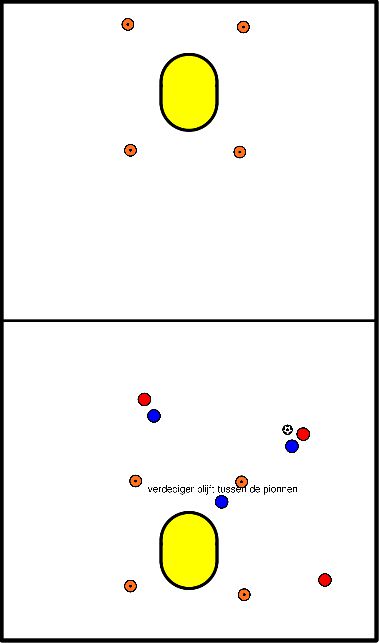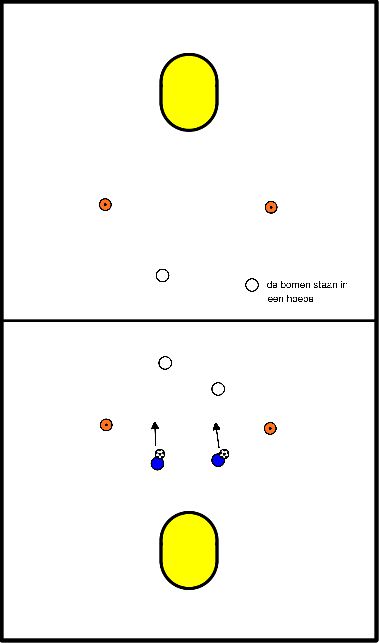Korfball drills
As a quieter exercise in between:
- 2-tal shoot under the post until the 11
- then the 11 again and back to 0.
To make it more difficult you can subtract 1 per miss or per time the ball falls to the ground.
Objective:
The base is a standard running form exercise, where you have players move back and forth in different ways to train general motor skills.
The tap game element adds responsiveness by having players react as quickly as possible and determine what they are going to do.
The tap game element adds responsiveness by having players react as quickly as possible and determine what they are going to do.
Description:
- The players stand on a line and are given a way by the trainer to run across each time, see also running forms.
- All players have a ribbon on, 1-3 players with the same color.
Occasionally, while walking back and forth, the trainer calls out the color of 1 of the ribbons. These then become the tickers. The tickers get 10 seconds to tap as many of the remaining players as possible. - Then all return to the same line and start a running form again.
- The idea is to start the tagging round immediately when the trainer calls a color and to quickly start the next running form when the tagging round is over. Keep up the pace.
Variations:
Instead of running forms where players walk back and forth, you can do movement exercises standing in the same spot. Examples include Jumping Jacks, sitting/lying and getting up again, jumping forward and backward, etc.
The trainer occasionally gives the next movement assignment and calls a color to start a tap round.
Running Forms:
Standard
- Running / Running backwards
- Hopping / Hopping backwards
- Sideways with front right / Sideways with front left
- Small steps
- Hopping on right / Hopping on left
- Cross pass
Jumps
- Jumps as large as possible.
- Medium-sized jumps and always balancing on 1 foot for a while before taking the next jump.
- With two feet side by side.
- With two feet side by side a big jump forward and another small jump back.
- With two feet zigzagging.
Arm movements to be combined with the above forms.
- Swing 1 arm forward or backward.
- Swing both arms forward, or both backward.
- 1 arm forward and 1 arm backward.
- Holding another body part with 1 or both arms.
As animals
- Frog; jumping on hands and feet.
- Crab; on hands and feet, with belly up.
- Kangaroo; jumping on two legs.
- Flamingo; hopping.
- Duck; crouching walk.
The trainer occasionally gives the next movement assignment and calls a color to start a tap round.
Running Forms:
Standard
- Running / Running backwards
- Hopping / Hopping backwards
- Sideways with front right / Sideways with front left
- Small steps
- Hopping on right / Hopping on left
- Cross pass
Jumps
- Jumps as large as possible.
- Medium-sized jumps and always balancing on 1 foot for a while before taking the next jump.
- With two feet side by side.
- With two feet side by side a big jump forward and another small jump back.
- With two feet zigzagging.
Arm movements to be combined with the above forms.
- Swing 1 arm forward or backward.
- Swing both arms forward, or both backward.
- 1 arm forward and 1 arm backward.
- Holding another body part with 1 or both arms.
As animals
- Frog; jumping on hands and feet.
- Crab; on hands and feet, with belly up.
- Kangaroo; jumping on two legs.
- Flamingo; hopping.
- Duck; crouching walk.
Same as pawn looting, but now you may loot people when you run out of pawns in the middle.
Game rules:
Game rules:
- Teams play against each other.
- Each team has its own basket.
- Instruct which shot is to be made, if this shot is in place then you may take a pawn from the middle
- Are the pawns gone then you may take a person from another team.
Goal
- Which team has robbed the most pawns/ players at the final signal.
or - Which team has robbed all the players at its basket.
Objective:
- Playing together and scoring on your own basket
- Or play together and prevent the opposing team from scoring as few goals as possible
Rules:
- Two teams in threes against each other (can also be played in fours)
- Around the basket there is a section where the defending side has a defender. The defender is only allowed to move in that section while defending. If the team is attacking, this player is allowed to join the attack. In this way there is always a surplus in the attack.
- Korfball rules are in force

- 16 hoops (or something else to make compartments) per 4 players.
- After scoring twice 5 meters with your pair you may place a pawn in one of the hoops.
- The first to get 4 in a row, horizontally, vertically or diagonally, wins.
- Can also be done with 3 (milk, butter, cheese and eggs).
- Each pair a basket and a ball.
- One of the two teams has a ribbon on his head.
- So you have a team with and a team without a ribbon.
- One player is the shooter and the other the catcher.
- Alternately a player with a ribbon and a player without a ribbon stand under the basket.
- We all start shooting at the same time.
- When a goal is scored, you change places.
- The team that is first under the basket has won.
- So if all players with/without a ribbon are under the basket, you've won.
- Shot game in 2 form playing against the other baskets.
- One of the two will shoot, when 2 times they score.
- Call to your coach: Are you the fastest, then you have won and there is exchanged,
- But not yet in possession of a point.
- You earn a point if your partner is also the fastest to score twice.
- So you earn a point if you win twice in a row.
- Variation is possible by means of penalty throws, walkthroughs, number of goals, etc.
- Each player gets his own pipsack.
- They are told an action by the trainer, which they perform.
- This can be touching your head, sitting down and standing up quickly, etcetera.
- As soon as Yes is called (or another action word), the piping bag can be taken.
- Bottle football only throwing.
- For each player there is one bottle filled with water.
- You choose a teammate against whom you want to play and so put the two bottles opposite each other with a few meters distance. (The further apart they are, the more difficult).
- You try to knock over your opponent's bottle.
- If you succeed, your opponent must first take the ball and only then can you put the bottle back up.
- You win if your opponent's bottle is empty.
- There are a number of hats all over the field, in different colours.
- The coach calls out 'white', then all children must run as fast as possible to a white hat.
- There is one hat too little for each colour, so the child who is not standing at a hat has to do an assignment of his own.
- Examples assignment:
- Run a circle.
- Push-ups.
- Jump 5x as high as possible.
- Pull a sprint.
- Score 2x at the basket.
- Make up 2/3 teams and do the following assignments:
- Pass balls
- Dropping balls (short distance)
- Penalty throw
- Distance shots (minimum 6 meters)
- Do all this for 2 minutes per person per task and write down the number of points you have scored.
- Try to bounce through 'the forest' without the 'trees' knocking the ball away with their 'branches', then score in the baskets behind the forest.
- Who has scored the most goals?
- Step 1:
- You may occasionally grip the ball with two hands.
- Step 2:
- You may occasionally bounce the ball with 2 hands.
- Step 3:
- You must do everything with one hand.
Rules:
- A runner may not hold the ball in 2 hands, but must bounce with 1 hand.
- A runner must stay within the lines or the forest.
- If the ball is tapped away from the runner, the runner will start over again.
- Make sure the children don't have to wait.
- Several runners start at the same time!
- If the runner manages to get out of the forest, the runner can:
- Step 1:
- Shoot at the cor until a score is scored.
- Step 2:
- Max. 1 shot.
- The 'tree' stays completely in the hoop or with one leg.
- Choice of the trainer.
- The 'tree' can tap the ball away with 2 hands or with one hand on the back.
- Choice of the trainer.








